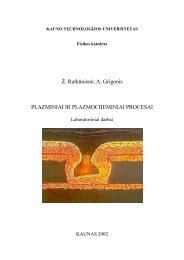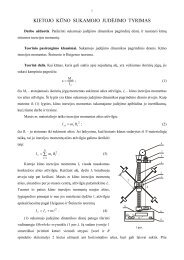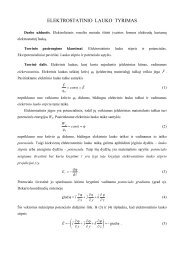PROCEEDINGS OF THE 7 INTERNATIONAL ... - Fizika
PROCEEDINGS OF THE 7 INTERNATIONAL ... - Fizika
PROCEEDINGS OF THE 7 INTERNATIONAL ... - Fizika
Create successful ePaper yourself
Turn your PDF publications into a flip-book with our unique Google optimized e-Paper software.
MEDICAL PHYSICS IN <strong>THE</strong> BALTIC STATES 7 (2009)<br />
Proceedings of International Conference “Medical Physics 2009”<br />
8 - 10 October 2009, Kaunas, Lithuania<br />
INFRARED SPECTROSCOPICAL STUDIES <strong>OF</strong> DISTRIBUTION <strong>OF</strong> CHEMICAL<br />
COMPONENTS IN URINARY STONES<br />
Milda PUČETAITĖ*, Valdas ŠABLINSKAS*, Vaiva HEDRIXSON**, Zita KUČINSKIENĖ**, Arūnas ŽELVYS***,<br />
Feliksas JANKEVIČIUS***<br />
*Dept. of General Physics and Spectroscopy, Faculty of Physics, Vilnius University; ** Dept. of Physiology,<br />
Biochemistry and Laboratory Medicine, Faculty of Medicine, Vilnius University; ***Centre of Urology, Vilniaus<br />
University Hospital Santariskių klinikos, Faculty of Medicine, Vilnius University<br />
Abstract: Kidney diseases which cause the occurrence of urinary stones are frequent in human pathology. The<br />
formation process of the stones is not fully understood therefore the studies of chemical composition and structure are<br />
of great importance. The means of Fourier transform infrared spectroscopy (FTIR) were used to determine the<br />
composition of the stones while FTIR microscopy was used to create chemical maps of cross-sectioned stones. The<br />
data from the study were used to analyze the formation process of the stones.<br />
Keywords: urinary stones, FTIR, microspectroscopic surface reflectance imaging<br />
1. Introduction<br />
The composition and structure of urinary stones is<br />
complex and depend on a variety of factors which<br />
include diet, sex, environment, metabolism, etc. The<br />
identification of the components and structure of the<br />
stone enables to find out the underlying cause of the<br />
disease, prescribe treatment and prevent recurrences<br />
[1].<br />
The qualitative and quantitative analysis of urinary<br />
calculi is challenging because of their usually small<br />
size, fragility, heterogeneous composition. Fourier<br />
transform infrared spectroscopy (FTIR) is easy and<br />
rapid method to obtain quantitative and qualitative<br />
information about chemical composition of the calculi<br />
even from small amount of the substance. In addition,<br />
this method enables to distinguish such similar<br />
components in the stones as calcium oxalate mono-<br />
and dihydrate. Microspectroscopic surface reflectance<br />
imaging is an informative method for analyzing<br />
morphology of cross-sectioned stones [2].<br />
2. Experimental<br />
Urinary stones for this study were surgically removed<br />
from patients in Vilnius University hospital Santariskiu<br />
klinikos. 2 mg of homogenized sample was finely<br />
grounded with potassium bromide (KBr) powder of<br />
spectroscopic purity and converted into a pellet using<br />
manually operated hydraulic press “Specac” exerting a<br />
pressure of 10 tons. The pellet was placed in the<br />
sample compartment of “Vertex 70” spectrometer from<br />
“Bruker” in the path of infrared radiation emitted by<br />
96<br />
“glowbar” light source. The spectrum was obtained<br />
using liquid nitrogen cooled MCT (mercury cadmium<br />
telluride) detector with 4 cm -1 spectral resolution. The<br />
spectrum was then matched against library spectra to<br />
identify various stone components.<br />
The cross-sectioned stones were fixed on glass<br />
microscope slides using two-component epoxidic glue<br />
and polished. Spectra were obtained using FTIR<br />
microscope “Hyperion 3000” from “Bruker” with<br />
single element MCT detector. The resolution of the<br />
spectrometer was set to 2 cm -1 . False-colour images<br />
representing the distribution of different chemical<br />
components in the urinary stones were obtained by<br />
integrating the area under the spectral band of specific<br />
chemical component. OPUS software was used for this<br />
purpose.<br />
3. Results and discussions<br />
In this study, the components found in the stones were:<br />
calcium oxalate (mono- and dihydrate), phosphates<br />
(carbapatite and brushite), uric acid and struvite. The<br />
majority of stones (~78%) are constituted from calcium<br />
oxalate with phosphate deposits. Some of the stones<br />
(~17%) are constituted from pure uric acid (Fig. 1) and<br />
the others (~5%) – from three components: calcium<br />
oxalate, phosphate and struvite (Fig. 2).<br />
FTIR spectroscopy allows distinguish two very similar<br />
substances: calcium oxalate monohydrate and calcium<br />
oxalate dihydrate [3]. Such analysis in this work was<br />
based on the position of C-O stretching spectral band.<br />
This band shifts from 1317 cm -1 for calcium oxalate








